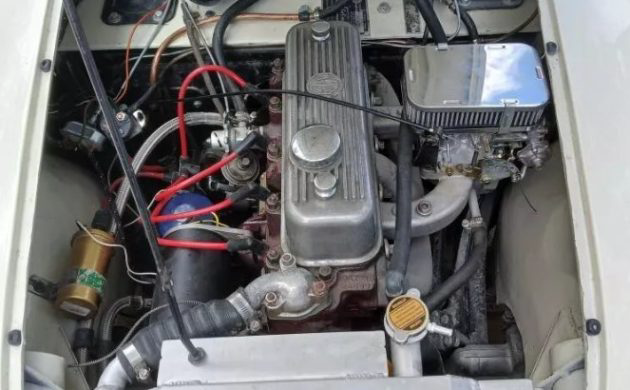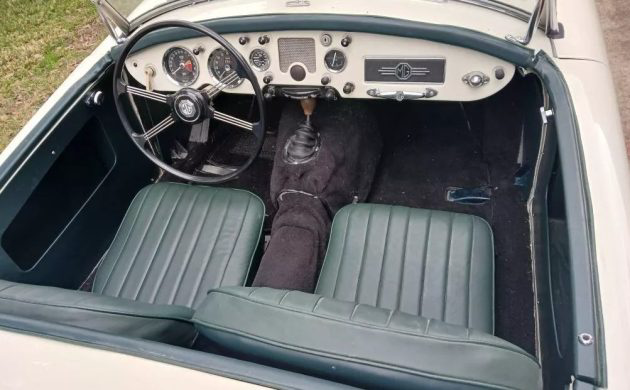We’re no strangers to the MGA at Barn Finds, and we’ve seen cars ranging from lost causes to stunningly restored. What is more unusual is to have two appear on our desks in quick succession that have received engine transplants from a donor MGB. The first one that we featured required major work, but this 1959 example is a turnkey proposition that presents superbly following a frame-off refurbishment. The seller has listed this MGA here on eBay in Cypress, Texas. Bidding sits at $12,900, and with No Reserve to muddy the water, it is days away from finding a new home.
MG introduced the MGA in 1955 as a more modern replacement for the aging T-Series range that culminated in the MG TF. It remained in production until 1962 when the company released the iconic MGB. Our feature car left the Abingdon factory in 1959, and if its recent cosmetic refurbishment followed a faithful path, the Old English White gracing its exterior should be the correct color. The seller pulled out all the stops during their build, stripping the car as part of a frame-off approach. The results are there for all to see because the paint is excellent, the panels are straight, and the gaps are consistent. There is no evidence or mention of rust, and the new Black soft-top should fit nicely if left raised for a while to shed its wrinkles. The trim and glass are excellent, as are the beautiful wire wheels. If the whitewalls don’t appeal to you, a solution is straightforward. The seller admits these are “Portawalls,” meaning removal would be pretty easy.
New to the MGA for the 1959 model year was an enlarged version of the early model’s 1,489cc BMC B-Series four. The company pushed the displacement to 1,588cc, which brought a welcome increase in power and torque. The figures remained modest, but the MGA offered excellent performance for its price. That is now irrelevant because this car now features a 1,798cc B-Series that started life in a later MGB. Its specifications are unclear, but it is fair to expect a further gain over the earliest MGAs. The seller doesn’t indicate whether the transmission is a four-speed manual, or whether the car benefits from the optional overdrive. They confirm that the refurbishment included an engine rebuild, a new clutch, and brake work that included fitting front discs. They say that the engine kicks into life easily and that this MGA runs and drives well. It is a turnkey proposition where the winning bidder could fly in and drive it home.
This MGA’s interior received as much love as the rest of the vehicle, and the only item worth criticizing is the poor carpet fit on the transmission tunnel. This could be understandable if the mechanical work included fitting the MGB’s transmission because the tunnel would have been modified if that was the case. Otherwise, it presents extremely well. The Green leather upholstered surfaces are spotless, the dash is excellent, and there are no issues with the banjo-style wheel. There is nothing inside this classic to suggest that it is anything but a sympathetically restored classic MGA.
The bidding history on this 1959 MGA suggests that people like what they see, and are willing to let their wallets do the talking. It appears to need nothing and is ready to be enjoyed during the upcoming summer months. That brings me to a question for you to consider. The MGA that we saw yesterday could be yours for $7,000 but needs a mountain of work before going anywhere near a road. We can speculate on the possible sale price for this 1959 example, but it is a turnkey proposition that can be enjoyed immediately. I know some people find the lure of a project irresistible, but would you prefer to join the bidding party to take this one home? I will understand if you do.









Beautiful car. One of my favorites. Interesting that putting the MGB engine in was followed by sticking the side draft carb on it negating the additional horse power. Wouldn’t have put the Portawalls on it but in truth most of the US cars from the UK came in with whitewall tires. When I bought my ’62 MG Midget new from the dealer it was in the showroom accompanied by an MGB and a Cobra. All three had white wall tires. My ’66 MGB also came with whitewalls.
Back when mere mortals could purchase a Cobra from a showroom.
In middle school (1966), I lived near a large “swinging singles” apartment complex in California that I would cut through enroute to school. One day, I noticed a red 289 Cobra in the parking lot (I was already a car nut). Acting on a hunch, I walked there on the weekend and met the owner. He was a young aerospace engineer who worked at nearby Vandenberg AFB. I recall that he said that he had paid around $5,500 for it. It was fun to watch him work on it, but, as a 13 year old, I never got up the courage to ask him for a ride. Bummer.
While it is obvious that you know your MG’s, you missed on the carburetter. This engine photo shows the down-draft Weber. It is difficult to believe that the “restoration” of this car is correct with such a poor method of delivering fuel to the later engine. Failing to use the correct dual SU’s on a car like this is just lazy. And let’s talk about the later engine. There is no mention of which of the later engines was used for the swap. Many of the later 18V engines were the low compression engine, post 74, sporting less than 75 horsepower that also included the very crack prone CAM1106 cylinder head. This could be the difference between a low compression, 70+-hp engine and a 90+hp engine. Maybe the reason for the low asking price. MGA’s have begun to devalue in the last couple of years, as in my experience, well prepared A’s have been bringing $20K since the mid 80’s. Wrong engine, wrong trans, wrong carburetter,,, wonder what else is wrong with this one?
Looking thru my CL listings for today, I find a red MGA for sale by the same owner, near the same price. Is this a dealer? This one also has the single downdraft Weber. I know I’m being picky about the aftermarket carburetter/intake, but I’m an SU rebuilder, and it pains me to see cars like this with the wrong fuel delivery systems.
Correct on the carb. 6:30 in the morning is too early for technical stuff. Still didn’t do it any good. Good comments on the later engines. Some of the smart MG folks went to the cross flow aluminum heads to get back some of that lost power.
When I think of British sports car, this is the first one that comes to mind. MGs, Triumphs, Austin-Healeys, these are cars in their own class. “Why not Jaguar”, you ask? Those are cars a class above. The ones I mention here were reasonably affordable and fun to own vehicles. This particular example would look nice in my garage. My only nit is I don’t care for the white dash, it should be black as I remembered all of them were back in the day. And if I got tired of the white-walls (tired, get it?), I’d just reverse mount them if possible.
Back in the day I purchased a new white MGA in 1957 and a new blue MGA in 1958. Both came with white dash boards.
These were all over when I was a kid. I haven’t seen one in years!
I’m always disappointed when I see an MG with a Weber downdraft carburetor. Any performance increase is purely imaginary. They run great with SUs.
They were all over when we were kids. I had a white 57 with solid wheels, cost about 1,000 dollars, had it 3 months. My last British sports car.
I would of put mirrors on the fenders
Two minor corrections: MGA’s never had an “optional overdrive” and MGA 1600s like this car had front disc brakes from the factory, so they weren’t “fitted” as part of the refurbishment. Only the 1500s had the front drums.
Also, painted white dash is correct for this car (body color).
Sweet-looking car, but the market for these is really shrinking, it seems.
I totally agree with Bruce. B engines run just fine with stock SU’s. Weber down draft carbs have their place but not on a B engine. A ‘B’ motor in an ‘A’ car is a good upgrade without changing the MG history of the car. This car is hands down a better value at 12K than the previous listed on for 7K. I also would get rid of the downdraft carb and the fat whitewalls and you have a nice classic to drive!! ( my preference only)
As a long time MG owner from TDs through Bs I can’t argue with keeping the SU carbs, though some folks don’t like to fiddle with them, however these cars don’t lose power using the Webers. I’ve raced MGAs and MGBs for several decades and in my experience many vintage race cars are switched to these resulting in an improvement in speed. They work very well on the track when your foot is either on it or off.
I didn’t look to see which B motor was used, but the early 3 main bearing is a much easier transplant than the later 5 bearing, which is arguably a stronger motor, though many prefer the 3 bearing for it’s ability to spin up quickly. If you are using the 3 bearing motor, fitting it to the MGA tranny is pretty straightforward. Otherwise changing to the B tranny is nice because you can have all synchro box and overdrive…which is lovely. Best swap is to use a Ford Sierra box (T-9) which gives you a 5 speed box and no overdrive issues. Recently they’ve started using Miata trannies in UK and these are a pleasure to use.
In the case of dash colour, these were most often colour matched with exterior paint except in some special editions or in the coupes which were covered with fabric.
Lastly, there are lots of MGAs which were fitted with mirrors on the fenders, usually right over the centerline of the front tires. The problems with this are they are a PIA to adjust as you need to sit in the car and direct someone else on how to move them to work best. More importantly, having the mirrors closer to you, mounted on the doors gives you a better, clearer, larger view of what’s around you. This is important is what is now a slower, lower car that most everything else being sold today….it was certainly important when racing these cars which is wny you’ll almost always see MG race cars with mirrors close to the cockpit.
Whitewalls were very common in the day and reversing the tires will give you the blackwall look if you’d rather, but that is all personal taste.
Porta-Walls are easy to get rid of – just do a short blast at 70 – 75 mph and centrifugal force will take care of them for you. If lucky, you will see them whizz by you if you slow down at just the right moment!
It makes no sense to rebuild an MGA 1500 or 1600 if you have access to a 5 main bearing MGB 1800.
My ’59 MGA 1600 came stock with drums in front. Don’t think discs were the rule until ’60?
+1 for SUs. Get them correctly set once and you never have to adjust them again. Had all kinds of MGs, from TC to a midget, never had anything but SUs on them, and wouldn’t waste my money on a Weber or any single downdraft.
If it had drums in front from the factory, it may have been a ’59 but wasn’t a 1600 (some 1500s were ’59s). When they went to the larger engine they upgraded the brakes. “Safety Fast.”
Nope Vance, mine was a ’59 with front drums and the original 1600 engine. Mine may have been a late ’59 and they were using up the front drum parts and using 1600 engines before the official model year cars were born.